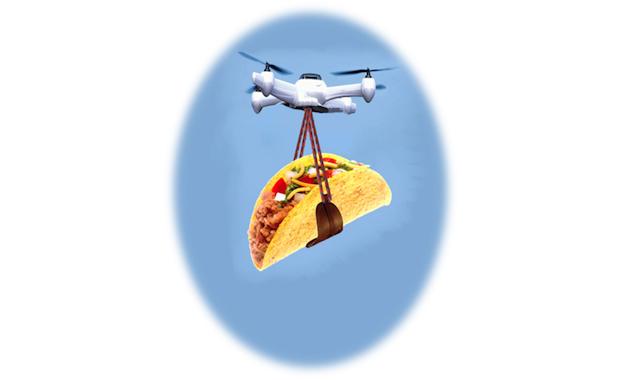Drone Delivery
I was reading this article the other day and got a good laugh. But I had to agree with the writer: “Here’s the idea as outlined on TacoCopter.com: customers download a smartphone app, which allows them to order tacos to a specific location. The tacos then arrive via flying quadcopter. Tipping your delivery drone is presumably optional. That’s it. It’s so brilliant, we can’t believe the kids down at the GRASP Lab haven’t already cornered the market on this.â€
The “Taco Copter†might be a joke, but the concept itself isn’t. And it’s implications need to be examined, because it has much broader impact than what you might see at first glance. It’s that phrase “delivery drone†that you should be focused on.
Because we are on the verge of creating exactly that; a fully automated end to end delivery system from factory to home. From the manufacturing robots to the “automated warehouse†run by drones to the soon-to-be-automated “self driving transport trucks†to the final link from the local delivery warehouse to you home via a quadcopter, it will soon be possible to create an item exactly when a person purchases it and then deliver it directly to the end user. Toss in the developments I discussed in “Adding our Way to Abundance†for H+ magazine with 3d printers making it possible for manufacturers to make any given item in an “on demand†manner, instead of the current “always on†production lines of the industrial era, and what you have is a recipe for unprecedented levels of customer convenience. Imagine ordering a taco on your smartphone during a traffic jam, and getting it brought to your car window. Imagine getting that new dress custom made to your measurements and delivered direct to your door. Imagine never having to travel to a grocery store — or to any kind of store — to shop again.
But that’s kind of tame compared to some of the other possibilities, like using quadcopters to create on demand supply systems for regions that have no roads, no airports, and no modern infrastructure of any kind.  That’s the idea behind “Matternet,â€Â a concept proposed at a recent Singularity University conference. Imagine a village in the Amazon having the same ability to order goods and services from half a world away that you do sitting right there in front of your computer. Then imagine a billion people all over the world being able to make products using native techniques and trade them with any other person in the world, directly, instead of having to go through some 3rd party that pays them pennies per dollar.
That’s what fully automated delivery networks using drones of various kinds could enable. Rather than a product only being available in certain regions, every corner of the world could be accessed as easily as your corner store. You could be walking down the street in NYC and have a drone home in on your smartphones gps location as easily as walking through the Amazon jungle. Military troops in the field could receive supplies just as easily. An expedition to Everest would be just as easy to reach with Quadcopters.
But even that’s not the end, because, as I pointed out in “Quadrotors Will Do Everything,â€Â simple delivery systems are merely the tip of the iceberg. Automated drone systems could not merely deliver goods, but provide services of all kinds, from construction to telepresence. Drones could, in fact, render many labor or people intensive jobs obsolete. A fully automated US Post office could run for a fraction of the cost of the current mail carriers. Drone trucks on our highways could be far safer by eliminating drivers who are too tired, or careless. Drone in those remaining retail stores could ensure they are always stocked, freeing the human workers to concentrate on customer service

